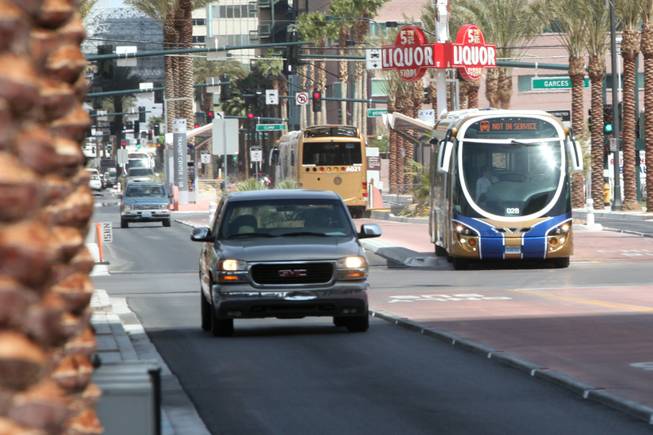
The Regional Transportation Commission, with 39 routes and more than 3,400 bus stops, marked its 25th anniversary this month.
Thursday, Dec. 14, 2017 | 2 a.m.
The Regional Transportation Commission of Southern Nevada celebrated its silver anniversary of operating the transit system in the Las Vegas Valley earlier this month.
Starting in 1992 with Citizens Area Transit (CAT) buses, the RTC has grown from 21 to 39 routes with more than 3,400 bus stops today.
With the valley’s population exploding from 856,000 in 1992 to 2.2 million today, the RTC transit system has more than tripled its services, from providing 19.4 million passenger trips per year in 1992 to more than 64 million trips annually. That ranks the RTC as the 15th busiest bus system in the nation by the National Transit Database.
An unlimited-ride monthly pass cost $20 in 1992. The cost for the last six years has been $65.
The RTC had one 24-hour route in 1992; it now has 13. The RTC has nine frequent-service routes today, compared to just one in 1992.
“To help put this growth into perspective, a person using transit on some of the valley’s busiest arterials at noon on a weekday in 1992 had to wait up to one hour for a bus,” said Jacob Simmons, RTC senior transit operations planner. “Today, that wait time is no more than 15 minutes.”
To address traffic-related issues brought on by NHL games in Las Vegas, the RTC recently launched four Golden Knights Express routes for the 2017-18 Vegas Golden Knights inaugural season, each providing nonstop service to T-Mobile Arena.
With six transit facilities throughout the Las Vegas Valley, the RTC opened its newest one in Downtown Summerlin earlier this fall.
The RTC marked its anniversary on Dec. 5, with staff members giving away prizes and breakfast items to riders at select stops.
“It may be the anniversary of the transit system, but we wanted to celebrate the people who have made our system successful — our riders,” said Tina Quigley, RTC general manager.
“We have achieved a lot of milestones in our 25 years, but I am even more excited for the next 25 years given the unbelievable advancements in technology that will transform transportation, and transit, as we know it.”
Technology
Using technology to improve customer experience has been a priority, RTC officials said. In late 2016, the agency introduced rideRTC, an app aimed at making each passenger’s trip more convenient. It’s been downloaded more than 100,000 times and has sold more than 218,000 bus passes since it launched.
“You can buy your ticket, you can plan your trip and see when the next bus is coming in the app,” said Raymond Hess, RTC director of planning. “That enhances the experience.”
This year, the RTC debuted free Wi-Fi on all its fixed-route vehicles. The customer amenity has important operational benefits — better real-time tracking of transit vehicles and on-board automated scanning of rideRTC mobile passes.
In addition, the RTC recently partnered with AAA, Keolis and the city of Las Vegas to launch the first driverless shuttle that runs in mixed traffic along a 0.6-mile route in downtown Las Vegas.
Safety
The RTC oversees 3,408 bus stops. About 62 percent have shelters or a bench.
Of those that have a shelter or bench, 60 percent have a shelter/bench behind the sidewalk (5 feet or more from the curb) and 40 percent have a shelter/bench on the sidewalk (less than 5 feet from the curb).
According to the American Association of State Highway and Transportation Officials, moving shelters back 5 feet or more can decrease the potential for a crash involving a shelter by 80 percent.
Since 2008, the RTC has invested nearly $22 million to build and move back more than 900 shelters at least 5 feet from the curb.
By mid 2018, the RTC will have pushed back all the shelters it can with the available right of way. RTC officials say they will continue to work with private property owners to acquire the necessary land to push back shelters for which the RTC does not have right of way.
“The RTC has spent considerable resources in the past several years attempting to move bus shelters farther behind the sidewalk,” Simmons said. “Pedestrian and bus stop safety is very high on our list.”
